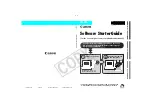
Restore Options
52 Agent for Microsoft SQL Server Guide
Leave database nonoperational, but able to restore additional
transaction logs
Instructs the restore operation
not
to roll back any uncommitted
transactions and to leave the database in a state where it can accept
additional Files-and-FileGroups, Differential, or Transaction Log restores.
You must choose either this option or the Leave database read-only option to
apply another differential backup or Transaction log after this restore job is
complete. This option is generally used when restoring a database from
multiple sessions without using Automatic Selection.
Leave database read-only and able to restore additional transaction
logs
Prepares a standby (warm backup) database. A standby database is a
second database on a different server which you can bring online if the
primary production server fails. It contains a copy of the database on the
primary server. The database is brought online in a special form of
Read-Only state which can be revered to a Restoring state if another restore
occurs. An Undo File is created during the restore which contains the
information SQL Server needs to make this transition. The location and
filename of the Undo File must be specified in the restore options.
Note:
Standby databases are not eligible for backup. If a standby database
is explicitly selected for backup, the backup will fail. If a SQL Server instance
which contains a standby database is selected for backup, the standby
database will be excluded by the agent.
For more information about standby servers, see Microsoft SQL Server
documentation.
Database Consistency Check (DBCC) Options
A database consistency check (DBCC) tests the physical and logical consistency
of a database. DBCC provides the following options:
After restore
Performs DBCC after the restore of the database.
Before restore
Performs DBCC before an Online Torn Page Repair restore of the database.
(SQL Server 2005 or later, Enterprise Edition only.)
Do not check indexes
Checks the database for consistency without checking indexes for
user-defined tables.
Note:
The system table indexes are checked regardless of whether you
select this option.
















































